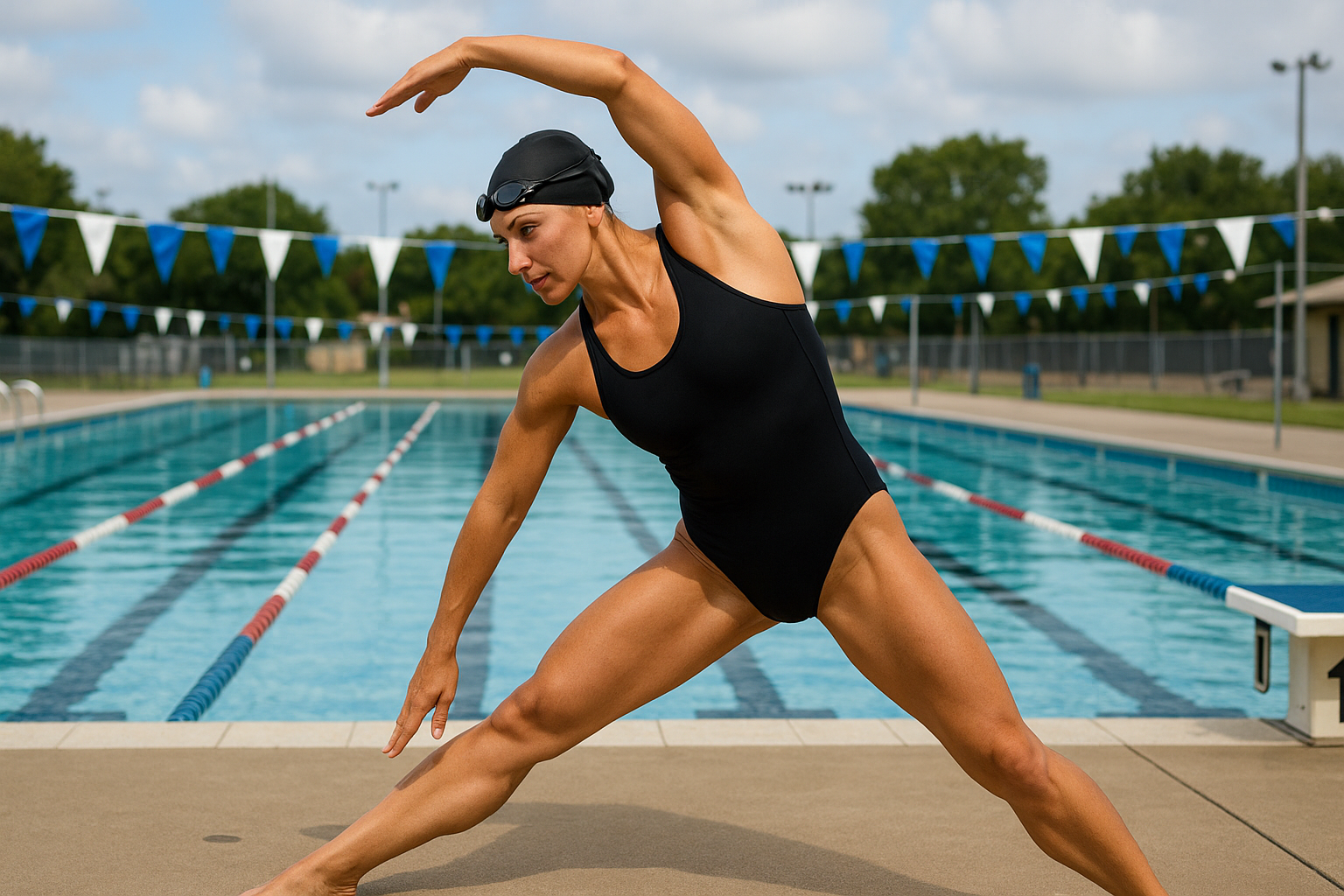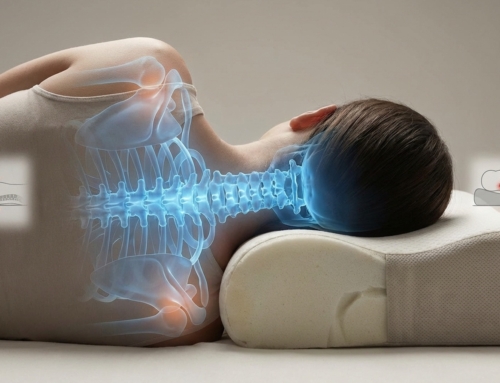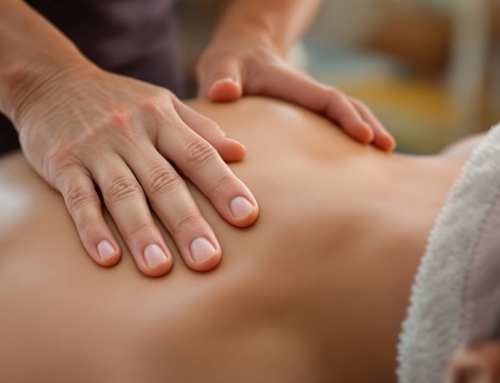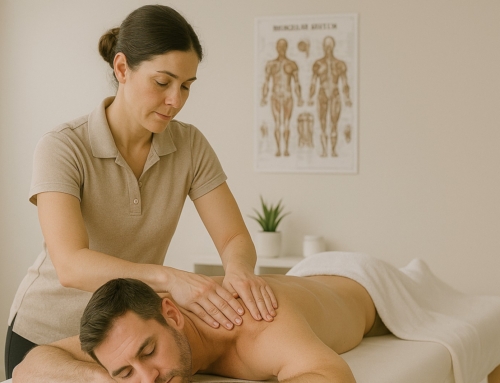We know full-well that swimming affects the spine, and effective stretching afterwards helps stop pain and stiffness. Within this write-up, we want to highlight simple moves that maintain spinal health and let muscles cool down in a controlled way.
If done correctly, these focused stretches ease tension in back muscles and improve flexibility once you leave the pool:
- Begin with gentle neck rotations, turning the head side to side, then tilting the ear toward the shoulder on both sides. Finish each turn slowly so neck joints have time to settle.
- For the lower back, lie down and try the knee-to-chest stretch, pulling one knee in for thirty seconds before switching.
- The cat-cow on hands and knees also works, alternating between arching and rounding the spine. Add a brief child’s pose at the end to help the lumbar region relax fully.
- Regular post-swim stretching lets muscles recover, keeps the spine aligned, and helps clear lactic acid. Hold each stretch for twenty to thirty seconds, breathe deeply, and avoid bouncing, which can irritate joints.
Importance of Post-Swim Stretches to Prevent Back Issues
If you’re not already doing it, we recommend post-swim stretches to keep the spine healthy by addressing muscle groups that work hardest in the water. While swimming already lifts spinal mobility in a low-impact way, adding moves such as the Cat-Camel or Swan takes flexibility further in the thoracic and lumbar zones. Lumbar mobility is important for swimmers, preventing lower-back tightness from kicking or uneven strength.
Be forewarned that prolonged sitting between sessions can shorten the hip flexors and weaken the core stabilizers. These stretches counter stiffness, reinforce core support, reduce pressure on joints, settle the nervous system, and improve alignment. Over time, they also promote better posture on land, which feeds back into cleaner stroke mechanics in the water, whether going for a swim in Clayton Heights or Cloverdale or Langley.
Key Stretches Targeting Neck and Shoulder Tension
Neck and shoulders often feel tight after laps because repetitive arm movements work the rotator cuff and upper traps. Targeted stretches help release this tension:
- Three-way neck stretches lengthen stiff muscles. Sit or stand tall, tilt the head forward, then to each side, pausing at each point for twenty seconds.
- Sleeper stretches improve posterior capsule flexibility. Lie on the side with the arm at ninety degrees, gently rotate the forearm toward the mat until a mild stretch is felt.
- Doorway pec stretches open the chest. Place forearms on either side of a doorway and lean forward slightly, holding for twenty-five seconds.
- A cross-body shoulder stretch that targets the posterior shoulder offers added relief and supports healthy scapular motion.
- Thoracic extensions on a foam roller and wall angles reset posture, encourage rib-cage expansion, and aid overall recovery.
Perform these movements slowly, keep breathing steadily, and avoid pushing past a mild stretch sensation to protect delicate shoulder tissues.
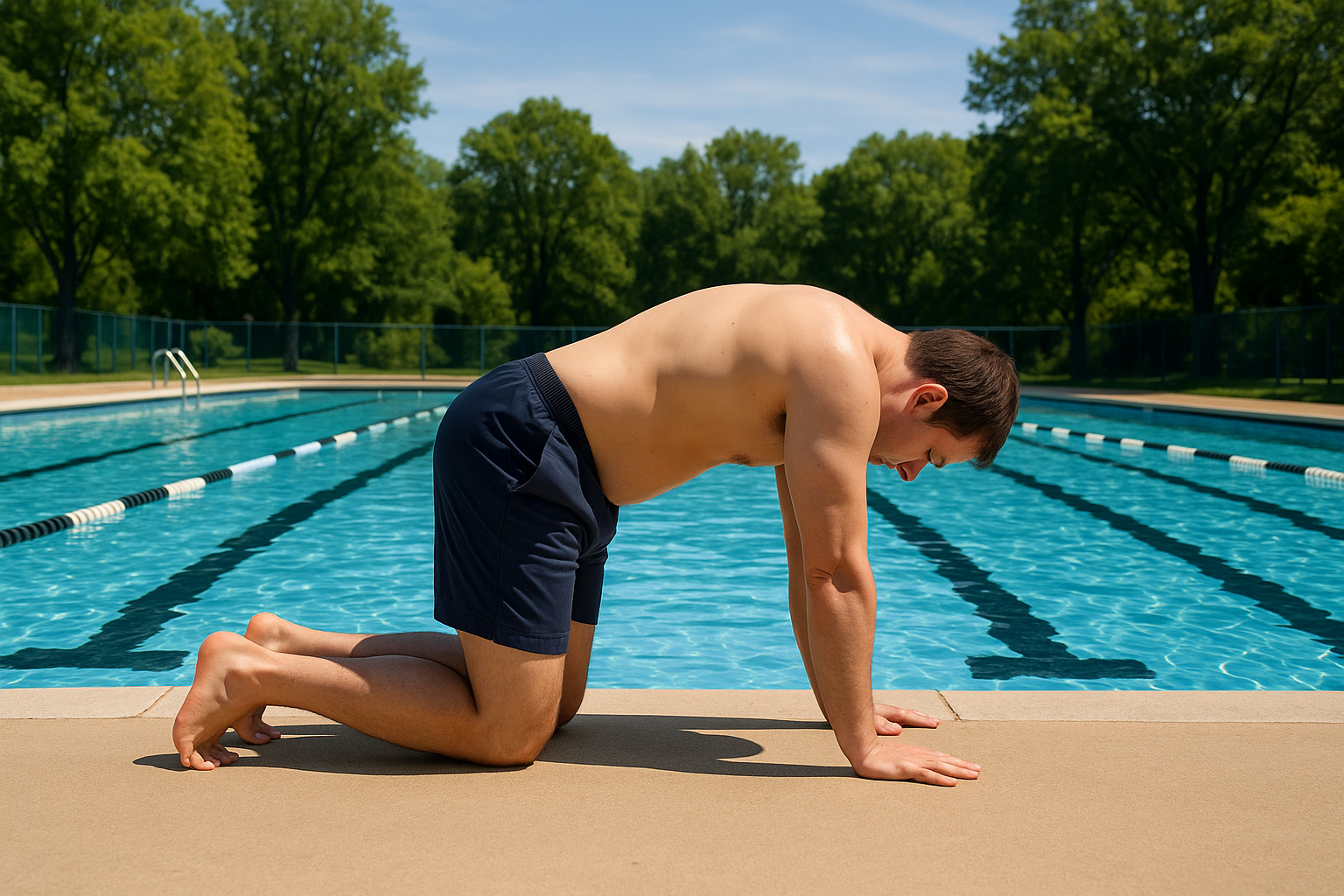
Lower Back and Hip Mobility Stretches for Spinal Support
Swimming stresses the lower back and hips because flutter and dolphin kicks rely on hip extension and core control. Stretches that boost mobility support the spine while maintaining efficient propulsion in the pool:
| Stretch | Why We Like It | How You Can Do It Safely |
|---|---|---|
| Kneeling hip-flexor stretch | Eases front-hip tightness and helps keep your lumbar area steady | Kneel on one knee, tuck your pelvis, and shift forward until you feel a gentle pull; hold 20–30 s each side |
| Active leg circles | Builds multi-plane mobility and steadier alignment | Lie on your back, lift one leg, draw small circles in the air for 15 s each way, then switch legs |
| Upright Dragon pose | Balances hip muscles and promotes pelvic harmony | From a low lunge, lift your torso upright, engage your core, and hold the position 20–30 s before changing sides |
Engage abdominal muscles lightly throughout each movement to prevent spinal sagging. If the lower back feels strained, shorten the range of motion until control improves.
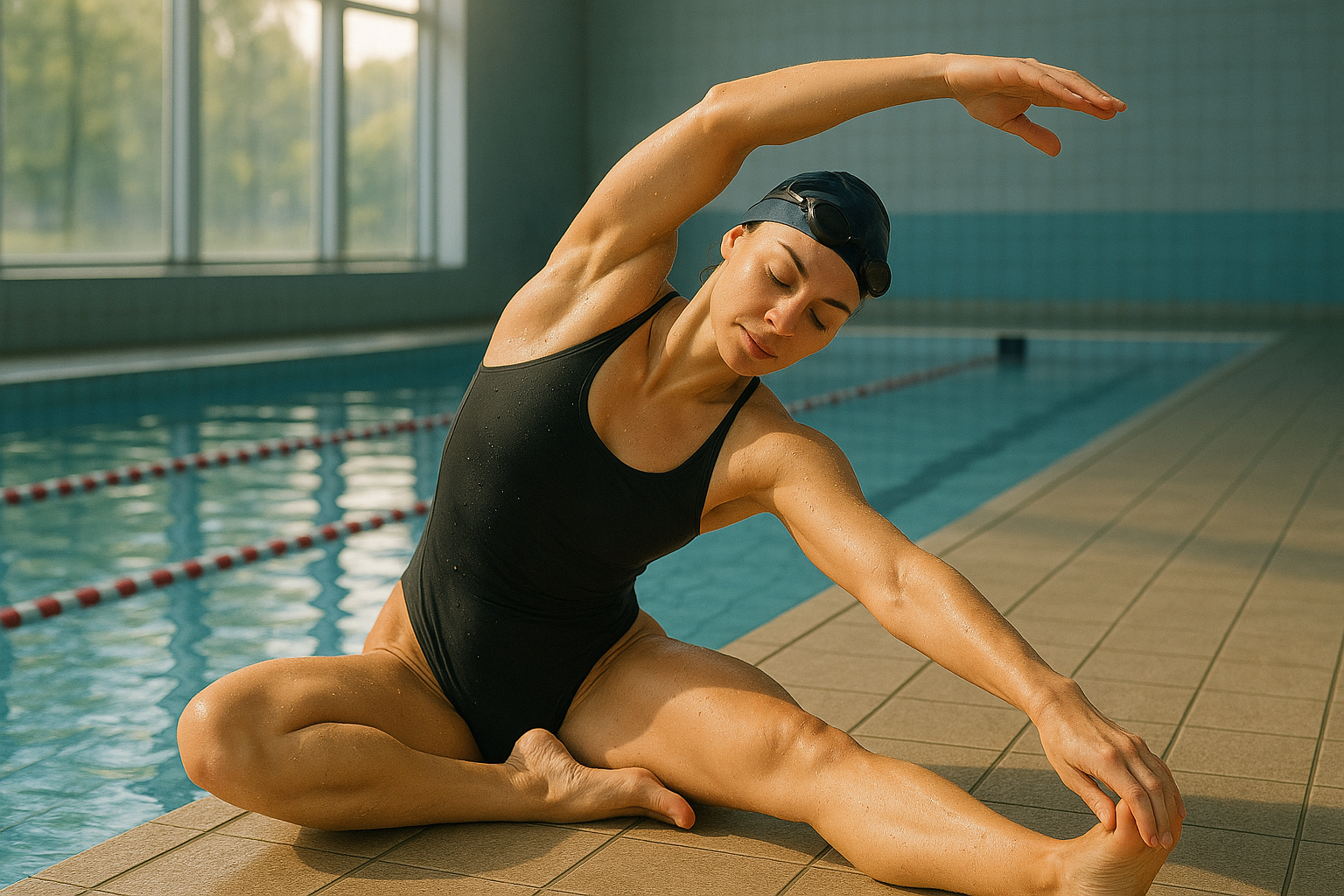
Chiropractic-Recommended Stretching Principles
Applying chiropractic concepts can make post-swim stretching more effective. Begin at the neck and move downward with controlled holds of fifteen to thirty seconds to raise flexibility with low risk. Warm muscles first with a few minutes of light cardio or shoulder rolls.
Keep the spine neutral during each stretch, pair every move with deep nasal-mouth breathing, and adjust routines daily to match current muscle tone or fatigue levels. Gradual progression is key; increase stretch time or range only when tissues feel ready.
Benefits of Combining Chiropractic Care With Post-Swim Stretching
When spinal adjustments correct joint positioning and stretching maintains soft-tissue length, the spine gains several advantages:
- Better flexibility reduces joint strain and supports smoother stroke mechanics.
- Combined care and stretching lower injury rates, shorten recovery windows, and cut post-session soreness.
- Improved neuromuscular coordination lifts endurance while promoting efficient energy transfer from core to limbs.
- Consistent mobility work also supports mental relaxation, helping swimmers recover psychologically between demanding sets.
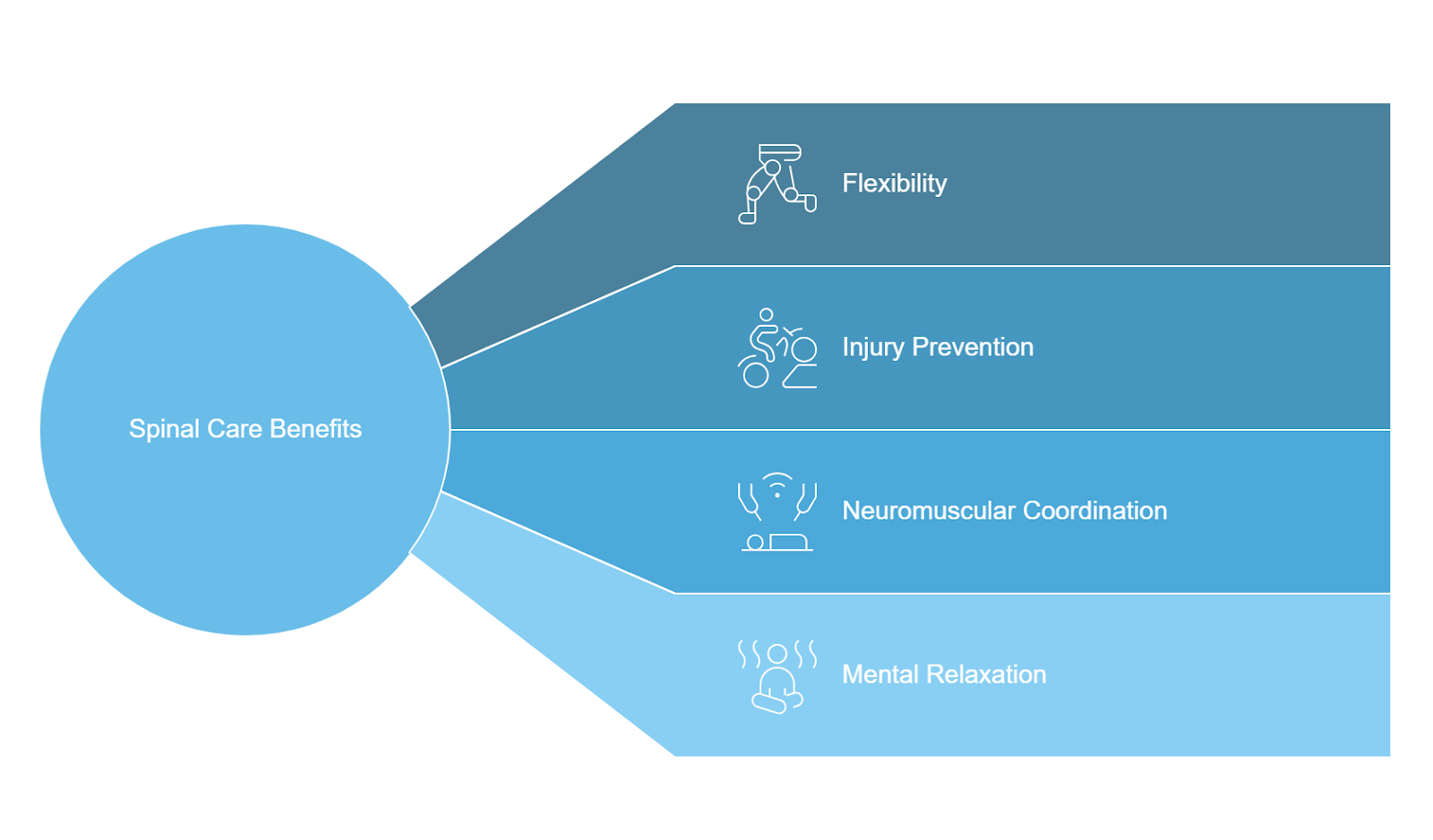
Frequently Asked Questions
How Often Should I Do Post-Swim Stretches Weekly
Stretch after every swim, typically three to five sessions each week, and add gentle daily moves such as seated twists or cat stretch for spine health. Include rest days to prevent overuse and allow tissues to rebuild.
What if Stretching Worsens My Back Pain?
Stop at once if pain increases. Seek professional assessment to identify underlying issues and receive guidance on suitable techniques or modifications.
Are These Stretches Safe for Beginners?
Yes, provided beginners start slowly, avoid forcing positions, and pay attention to any warning signals such as sharp pain or numbness. Qualified instruction can help refine technique.
Can I Modify Stretches for Existing Injuries?
Yes, you absolutely can modify stretches for existing injuries. We recommend adapting your stretching routine to work around your specific limitations and pain points.
We work with you to create gentle, pain-free modifications that support your healing process rather than aggravate your injury. Our approach focuses on gradual progress, starting with smaller ranges of motion and building up slowly as your body allows.
With proper chiropractic guidance, we help you identify which stretches need adjustment and how to perform them safely. This might mean reducing the intensity, changing your position, or using props for support. The goal is to maintain your mobility whilst protecting your injured area and promoting recovery.
How to Incorporate Breathing During Stretches?
We sync our breathing with stretching by inhaling through our nose and exhaling through your mouth. This timing helps you relax and align your body properly during each hold. We focus on deep, full breaths that help deepen your spinal flexibility and support your recovery process.

